|
< Earlier Kibitzing · PAGE 2 OF 2 ·
Later Kibitzing> |
| Feb-23-16 | | Afroim: It's interesting to notice that pawn e3 is not important for blacks. For example, if the game came to this position 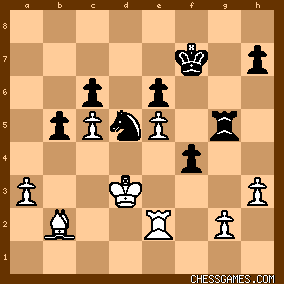
click for larger view the same move 36 ... f3 would be winning: 37. Rf2 Nf4+ and then 38 ... fg2  |
|
| Feb-23-16 | | cocker: Fork, and skewer with 39 ... Rg2+ to make the combination much stronger. |
|
| Feb-23-16 | | Once: <Penguincw> Having trouble spotting knight forks? Let me show you a position which helped me with visualisation. 
click for larger viewThe black knight on d4 can hit every white bishop. Every pair of bishops is being forked. The first thing to notice is that the knight sits on a black square and all the bishops are on white squares. That's the first rule of fork club. The pieces being forked are always on the same colour squares as each other and the opposite colour square to the knight. Now pick two bishops close to each other. The patterns they make are all the fork patterns. In fact, the only combination of same colour squares that isn't knight forkable is this one: 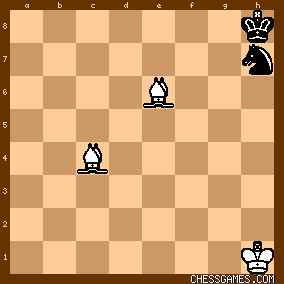
click for larger viewThere is no square from which the black knight can fork those bishops. But a fork is possible for just about every other pair of same colour squares. I once sat down with a board and a set of pieces and spent a happy couple of hours doing nothing except playing with fork patterns. That helps with positions like today's which reduces down to this: 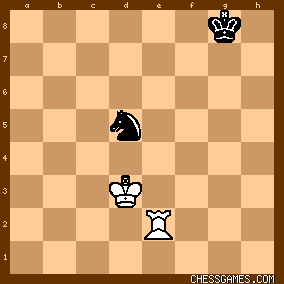
click for larger viewKnight forks get a lot easier once you get this same colour/ opposite colour thing in your head. |
|
| Feb-23-16 | | Once: I ought to say before the nitpickers start picking nits, when I say that just about every pair of same colour squares is knight forkable, I mean every combination of <close> same colour squares. The knight can't yet leap from one side of the board to another. |
|
| Feb-23-16 | | CHESSTTCAMPS: Black has N+P for a bad bishop. Worse yet for white is that the extra pawn is passed, protected, and on the 6th rank, completely tying down white's pieces. Black can finish simply with 36... f3
A.37.gxf3 Nf4+ 38.Kxe3 Nxe2 39.Kxe2 (Kf2 Rxh3 also leaves black a rook ahead) Rg2+ wins white's remaining piece. B.37.Re1 fxg2 38.Rg1 Nxf4+ 39.Ke4 Nxh3 wins. |
|
| Feb-23-16 | | CHESSTTCAMPS: <Once> Your first diagram is one I love to show beginners using pawns. With bishops it looks much more spectacular. Unfortunately most demo board sets don't have that many! |
|
| Feb-23-16 | | Oxspawn: No, no <Once> you have a bigger issue with nitpickers picking nits! It is evident from the position that you managed to get seven white pawns to the eighth rank and for some reason you decided to promote them all to bishops - but making sure they all arrived on white squares must have been quite a challenge. That probably exhausted you to the point where you fell into black's trap - to fork all eight bishops simultaneously. Of course black taking one of the bishops will mean sacrificing the knight. But it will be a draw won't it so long as the black king sticks to the black squares? |
|
| Feb-23-16 | | dfcx: spent a long time looking at Rxg2 and could not make it work. So back to think about the knight fork at f4 - it all fits. 36...f3!
A. 37.gxf3 Nf4+ 38.Kxe3 Ne2 39.Kxe2 Rxg2+ 40.Kd3 Rxb2 B. 37.Rxe3 Nxe3 38.Kxe3 fxg2+ and promotes next
C. 37.Rc2 fxg2 and g1=Q next
D. 37.Re1 Rxg2 38.Bc3 f2 39.Rf1 Rg1 40.Ke2 Nf4+ 41.Kxe3 Rxf1 42.Ke2 Rc1 43.Kxf2 Rxc3 |
|
Feb-23-16
 | | Sally Simpson: Hi Penguin,
It's surprising how often a players sees a Knight fork, makes a move to prevent it and gets forked on a different square. Just last week in a corres net game, my opponent had 4-5 days to move. This is the bones of the position. 
click for larger viewI'm threatening Ne6+ he saw it and his move to prevent was Kh6. 
click for larger viewNo fork e6 but what about f7. 1-0.
Blitz Tip No.193.
In an ending if you opponent has an annoying active Knight threatening to fork things then automatically stick the King 1 diagonal away from the Knight thus: 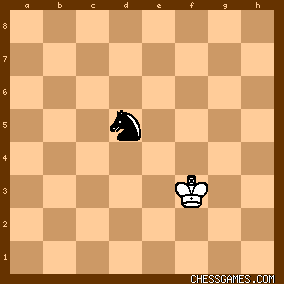
click for larger viewYou can rest assured no nasty Knight fork is coming your way for at least 3 precious blitz moves. That is how it will take a Knight to check the King in that pattern. ----
Here:

click for larger viewAll depends what you need, a win or a draw.
If you need a win then don't take all his Bishops, leave him at least one, you need to get a position akin to this. 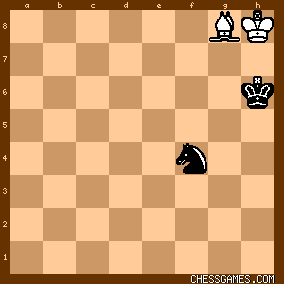
click for larger viewBlack plays Ng6 mate.
If all you need is a draw then get rid of you Knight pronto before you walk into this pattern. 
click for larger viewWhite plays Bb7 mate. |
|
| Feb-23-16 | | luftforlife: <kkdogg>: I don't know whether or not you happen to be a radiologist, but you sure know how to read an X-ray! Thanks for your penetrating insight. ~ lufty |
|
| Feb-23-16 | | jith1207: <Oxspawn>: I am just Nitpicking the Nitpicker. :D If White had managed to move up the pawns in seven different squares, would have got at least one dark squared Bishop to make a Check ;-) |
|
| Feb-23-16 | | ASchultz: <Cybe> I also wondered why Black didn't play f3 instead of Kf7 but a chess engine says Black can walk in and take the e5 pawn. Kd4 and Rg8 threatens Rd8 or Ra8. |
|
| Feb-23-16 | | YetAnotherAmateur: I was pleased to also see 36. ... f3. White has a number of responses, but none of them lead to anything good: 37. Rxe3 f2 looks pretty darn good for black, e.g. 38. Rxg3 f1=Q, or 38. Ke2 Rxe3+. 37. Re1 f2 38. Rf1 Nf4+ 39. Ke4 e2 and there's not much more to be said. Most other attempts fail to either fxe2 or Nf4+. I'm not surprised white resigned in this position. |
|
| Feb-23-16 | | Longview: Hang in there <Penguincw> I got the puzzle but missed the fork possibility! Ha! My flaws are similar and for the life of me I cannot see the pinned piece that cannot move. Trying to solve these everyday will help though. I am at the point where I can solve about 50% of Wednesdays now. The calculation practice and the comments of many of the Kibitzers really is helpful. Thanks <Once> for the example to study. and <Sally S> for your clear example. I hate playing Blitz because I miss these types of things but tricks like that will help. |
|
| Feb-23-16 | | JustAFish: Oh darn. I made the mistake of:
1) ... Rxg2
2) Rxg2 f3
3) Rg3 e2
4) Rxf3 e1=Q (illegal move)
I didn't see that Rxf3 was check! |
|
Feb-23-16
 | | OhioChessFan: Re <Penguin> and <Longview> While I know it can puzzle people why decent players can miss stuff like a Knight fork, I know there are all kinds of areas of chess blindness. I have a hard time with long moves, eg a Bishop on a7 checking a King on g1, and miss some basic tactics, such as the pins involved. |
|
| Feb-23-16 | | saturn2: f3 could have been played one move earlier instead of the king move. Maybe black missed it first but white granted him a second chance |
|
| Feb-23-16 | | kevin86: 36... f3!! clears out the f4 square for the fatal knight fork! |
|
| Feb-23-16 | | Oxspawn: <jith1207> Yes, a black bishop would have been nice but not inevitable. I imagine that <Once> walked four of the pawns to available white squares on rank 8, and then the other three pawns took (diagonally) on their final move to end on white squares. I look forward to seeing the full game. Possibly a Sunday puzzle. |
|
| Feb-23-16 | | BOSTER: < saturn2: f3 could have been played one move earlier>.
The main difference between the pos black to play 35... and black to play 36...is that after f3 gxf3 if Nf4+ Kxe3 Nxe2 Kxe2 white bishop after 36.Bb2 is on the same line with white king after Kxe2.
So, R g2+ is the key . |
|
| Feb-23-16 | | Once: <Oxspawn> Actually, it's a scene from the Matrix. The black knight is Neo and the white bishops are Agent Smith. "Do not try and bend the spoon, that's impossible. Instead, only try to realize the truth...there is no spoon. Then you will see it is not the spoon that bends, it is only yourself." |
|
| Feb-23-16 | | Conrad93: This puzzle is a little too easy for two and a half stars. |
|
Feb-23-16
 | | Bubo bubo: My first thought was 36...Rxg2 37.Rxg2 f3, but <two passed pawns on 6th rank vs rook> does not work here since the white king is already close to the pawns. Therefore 36...f3!, and now
A) 37.Rxe3 Nxe3 wins a rook because of 38.Kxe3 fxg2.
B) 37.gxf3 Nf4+ 38.Kxe3 Nxe2 39.Kxe2 Rg2+ and 40...Rxb2 wins a rook, too. C) 37.Rc2 Rxg2 threatens 38...Rxc2 39.Kxc2 f2, and White has no sufficient defense: 38.Rc1 Rxb2 or 38.Rxg2 fxg2. D) 37.Re1 f2 38.R~1 Nf4+ 39.Ke4/c2 e2, and one pawn is bound to promote. |
|
| Feb-24-16 | | saturn2: <BOSTER> I agree but only partly. You are right in saying that here black does not get the bishop, but I am also right because 35..f4 is stronger than the king move. It allows the knight fork and leeds to a won ending which various posters suggested as the puzzle solution. |
|
| Mar-01-16 | | WorstPlayerEver: Hmm.. after 22. f4 Qd2 23. Kf2 Rh3 the game is finished. Nice try though. |
|
 |
|
< Earlier Kibitzing · PAGE 2 OF 2 ·
Later Kibitzing> |





